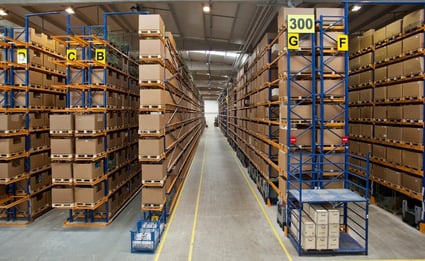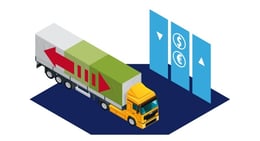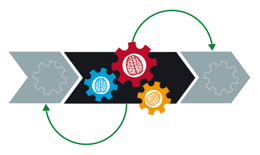How to Forecast Demand in Manufacturing
Jesse Kelber - July 16, 2019

Demand forecasting plays an important role in manufacturing. That fact isn’t changing; what is changing is how it’s done. Whereas in the past, forecasting had an aura of magic about it, relying heavily on the intuition and experience of the planner doing the forecasting, today it’s largely a data-driven practice. Before Industry 4.0, historical data was combined with gut feelings to produce a sort of crystal ball-like prediction of what the future held for the company in terms of demand and buyer behavior, and by extension what the company should focus on producing. Everyone basically crossed their fingers and hoped for the best. Post-Industry 4.0, this has changed dramatically, with a heavy reliance on advanced predictive analytics being fed data from IoT sensors deployed throughout the supply chain.
So, what does all that have to do with forecasting demand at your manufacturing company? With the emerging technologies of Industry 4.0 backing you up, it means your forecasts can be more accurate, more timely, and less prone to error than ever before.
Demand Forecasting with Industry 4.0: It’s All About the Data
With the increasing adoption of Industry 4.0 practices and technologies, manufacturing companies are increasingly deploying IoT sensors on the factory floor. These sensors collect data and report, in real-time, on the health of production machinery, track production statistics, monitor supply levels, and more. The real-time nature of these sensors means that planners have, for the first time, access to every situation in the factory, in the warehouse, and in the logistics chain as it unfolds. It’s this immediate increase in visibility that is changing the face of demand forecasting in the manufacturing industry. The ability to blend this operational information with external data ranging from shipping conditions, supply availability, partner/supplier issues, and so on is where the power of data comes to light.
By its very nature, data is agnostic. The numbers don’t lie, and the sensors don’t return made up statistics. When it comes to demand forecasting, the accuracy of the data is paramount and today’s emerging technology can deliver. With up-to-the-minute availability of everything from customer buying habits, supply levels, material costs, and granular details about your customers and their behaviors, your predictive analytics workflow will return the most accurate predictions ever possible. Gone are the days of crystal balls and relying on the sole intuition of the one person who’s been at the company the longest. The 21st-century is ushering in the days of data-centric demand forecasting. With this new accuracy and power come some key points to remember, like the importance of visibility to the process.
Data-centric Demand Forecasting Relies on Transparency
For this increased level of accuracy, the transparency of all related business processes is paramount. The entire end-to-end supply chain is where the needed data is located, and the ability to see it all is required for predictive analytics tools to be as accurate as possible. Basically, the more data the better. It’s the information collected from your production systems that feeds the algorithms that are going to churn out the actual forecast predictions, so it’s imperative for the systems to be in place that provide this level of complete visibility. Unfortunately, most businesses in the auto industry (to use just one example) aren't quite there yet: 9 out of 10 carmakers admit that their logistics master data is old or has significant gaps. That said, deploying process mining to uncover process inefficiencies, IoT sensors to gather data, and advanced analytics to comb the resulting data pile are the best ways to get started.
The visibility provided by this combination of software and advanced IoT technology highlights each step of the supply chain that comes into play in building a demand forecast. When you know not only how many units you can produce right now, but also what your customer buying habits look like, you’re much better positioned to regulate supply orders and thereby eliminate storage costs for unsold products. And if you can meter out supply orders to cut inventory storage costs on that end of the value chain as well, you’re saving even more overhead that can be used for future endeavors or unforeseen disruptions. Given the nature of those possible disruptions, from shipping cost fluctuations, political unrest in various regions, and unpredictable weather patterns, it’s no wonder the increased visibility afforded by these technologies is so vital.
The best, and simplest, way to accomplish this level of transparency is to first adopt a postmodern ERP mindset. This methodology helps eliminate data silos by ensuring all IT systems across the organization are integrated. Updating legacy systems so that they can communicate and transmit data in formats that other systems can read is step 2. Both of these allow for the creation of a single source of truth for your manufacturing concern. SSOTs are the data storehouse used by other Industry 4.0 tools to mine for data and supply it to the analytics tools to produce your new demand forecasts. Creating this warehouse of company data helps do away with the information silos that often held back forecasts in years past.
Transparency Goes Both Ways
Thus far we’ve talked about data, technology, and planning methodologies, but forecasting involves the whole company, so obtaining buy-in is just as critical a component of any planning activities. One last step to perform is to ensure your own work in forecasting is as transparent as everyone else’s is now. By conducting group sessions where you outline the ways having access to this data is improving the accuracy of your predictions, you’re able to position yourself as a trustworthy ally in the quest to grow the business and increase the ROI of every investment you’re asking for. By highlighting the ways this new, post-industry 4.0 approach is better than the old crystal ball version, you’re ensuring that buy-in from even the most die-hard traditionalists among your coworkers. Then, once you have results, you can provide them to the higher-ups, parading the remarkable results and improvements in your forecasts that this technology investment empowered will help ensure continuing support as you move the company’s digital transformation forward.
Look at it like this, when you have a big weekend planned, you check the weather forecasts before leaving town, right? You need to know if you should be packing the deck chairs, mountain bikes, and sunscreen, or the umbrellas and books. Which forecast do you put your faith in? The neighbor who says it’s going to rain based on tingling in their arthritic knee? Or the website that pulls data from the national weather service and combines that with historical data and known weather patterns? Exactly. Manufacturing demand forecasting isn’t actually all that different. It relies on past data, current conditions, and future predictions to help ensure your value chain stays on course and that production levels and sales stay on target.
If you want to learn more get your Guide to Industry 4.0:
LATEST POSTS
- Understand Circular Economy in The Manufacturing Industry
- How Can Industry 4.0 IT Integration Be Achieved Smoothly?
- The Significance of Order Sequencing in Discrete Manufacturing
- How to improve your Supply Chain Management: The Power of Control Towers
- Optimizing Human Resource Scheduling in Manufacturing: A Technological Approach



